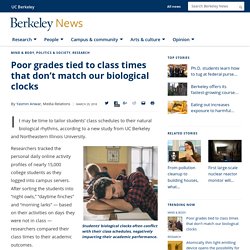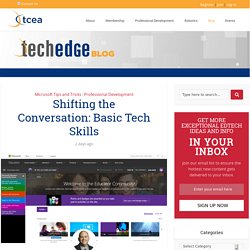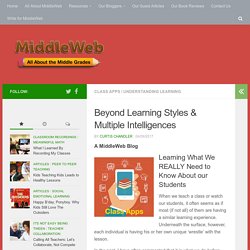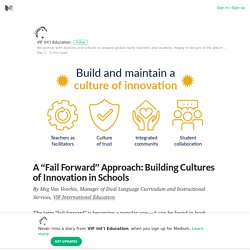

Poor grades tied to class times that don’t match our biological clocks. It may be time to tailor students’ class schedules to their natural biological rhythms, according to a new study from UC Berkeley and Northeastern Illinois University.

Students’ biological clocks often conflict with their class schedules, negatively impacting their academic performance. Researchers tracked the personal daily online activity profiles of nearly 15,000 college students as they logged into campus servers. The impact of classroom design on pupils' learning: Final results of a holistic, multi-level analysis - ScienceDirect. Assessments have been made of 153 classrooms in 27 schools in order to identify the impact of the physical classroom features on the academic progress of the 3766 pupils who occupied each of those specific spaces.

This study confirms the utility of the naturalness, individuality and stimulation (or more memorably, SIN) conceptual model as a vehicle to organise and study the full range of sensory impacts experienced by an individual occupying a given space. In this particular case the naturalness design principle accounts for around 50% of the impact on learning, with the other two accounting for roughly a quarter each. Within this structure, seven key design parameters have been identified that together explain 16% of the variation in pupils' academic progress achieved. These are Light, Temperature, Air Quality, Ownership, Flexibility, Complexity and Colour. The muted impact of the whole-building level of analysis provides some support for the importance of “inside-out design”. Research-Influenced Learning Spaces. The Office Of The Future Will Be Natural, Chair-less, And Designed For Collaboration. Plusnet, a U.K.

Internet service provider, interviewed a dozen futurists and office design experts about the office circa 2030. The consensus is that workspaces generally will become more flexible (to accommodate different types of employees), more collaborative (this is the way work is going), and more natural. There’s a ton of research showing that employees are happier and more productive when exposed to nature.
So, organizations will increasingly look to incorporate natural light whenever possible. Microlearning Online Training Activities: 8 Unexpected Ways To Use Them. Microlearning improves knowledge retention and gives employees the ability to brush up on skills whenever it’s most convenient.

In this article, we’ll discuss 8 unexpected ways to integrate microlearning online training activities in your corporate eLearning program. Bite-sized online training resources help employees broaden their understanding and explore the subject matter autonomously. They also allow them to build essential work skills and continually improve their performance. As such, they’re a great addition to your online training program, especially if you want to increase employee satisfaction and improve your corporate eLearning ROI. Here are 8 unexpected ways to integrate microlearning online training activities into your current online training strategy. Online Learning 3.0 Is Happening And You’re Probably Behind - eLearning Industry. Shifting the Conversation: Basic Tech Skills - TechNotes Blog - TCEA. Rather than focusing on building basic tech skills in teachers, first shift the conversation to what they must know in order to teach today’s students.

Learning What We REALLY Need to Know About our Students. A MiddleWeb Blog Learning What We REALLY Need to Know About our Students When we teach a class or watch our students, it often seems as if most (if not all) of them are having a similar learning experience.

Underneath the surface, however, each individual is having his or her own unique ‘wrestle’ with the lesson. In the past, I have often commented that it is what we do before and after class that determines the success (or failure) of a lesson. And I have long admired teachers who develop intricate systems of data collection that they use to diagnose student needs and to plan effective instructional supports.
Teaching Skills List For Resumes And Cover Letters. When you're writing resumes and cover letters and applying for teaching jobs, there are certain skills that schools and other organizations that hire teachers expect you to have.

While many skills required for a teaching job depend on the school and the grade you are teaching, there are a number of skills needed for almost any teaching position. Below is a list of five teaching skills that employers often want in a teacher, as well as a longer list of other teaching skills. How to Use Skills Lists You can use these skills lists throughout your job search process. On Flipboard.
Classroom Management: Why & How. On Flipboard. A “Fail Forward” Approach: Building Cultures of Innovation in Schools. By Meg Van Voorhis, Manager of Dual Language Curriculum and Instructional Services, VIF International Education The term “fail forward” is becoming a popular one — it can be found in book titles, TED talks and even business ideologies.

But what does this approach really look like within the context of a school environment, and how does it promote cultures of innovation? In a 2015 Edweek post, “Fail Fast, Fail Forward” was the first out of the four steps listed to promote a culture of innovation in the classroom. Failure, though, is not an easy topic to discuss with educators who often feel overly scrutinized and undervalued. I recently had the opportunity to speak with Jason Jowers, principal at Global Scholars Academy, a charter school within Durham Public Schools (DPS) in North Carolina. Jowers has done his fair share of creative experimentation beginning with his time as a classroom teacher, and not all of the experiments succeeded. Train teachers as facilitators. District Administration Magazine. As in years past, this new year will bring all sorts of new technology to schools.

The question for educators is: To what degree do these technologies enhance education? “Figuring out which tech belongs in education is just the start,” says Kelly J. Calhoun, research director at Gartner Research, a Connecticut-based market analysis firm. “The real hard work is adapting it to help in the classroom.” Hundreds of new technologies appear every decade, but only a few end up having a lasting impact on education. “We’re often wrong when we try to predict the future,” adds Calhoun, “but the act makes us think about what we need today and how we can provide it tomorrow. Online hand-in Forget about paper worksheets, local networks and USB thumb drives. When students transfer work to the online storage center, a notification pops up on the teacher’s dashboard. What Does a 'Modern Classroom' Look Like—and What Should Educators Leave Behind? What Does a 'Modern Classroom' Look Like—and What Should Educators Leave Behind?
Express 12.07 - With-It Teachers Use ESP. On Flipboard. 85 Canadian Schools Lead an Edtech Charge by Moving from Devices to Deeper Learning. About 'Those Lazy Teachers': A Letter From An Educator. What Is Successful Technology Integration? Technology integration is the use of technology resources -- computers, mobile devices like smartphones and tablets, digital cameras, social media platforms and networks, software applications, the Internet, etc. -- in daily classroom practices, and in the management of a school. 32 Research-Based Instructional Strategies - 32 Research-Based Instructional Strategies by TeachThought Staff.

3 Instructional Strategies to Support Literacy in all Classrooms. Finnish Teachers Opt for Less Structured Start of School Year. Heading into my first year of teaching in Helsinki I felt pretty nervous. One of my graduate-school professors—a former Massachusetts Teacher of the Year—had warned me that Finnish students were academically advanced, especially in math. Indeed, Finland’s students had excelled on international standardized tests like the PISA for more than a decade. But it wasn’t just those high-performing Finnish students that intimidated me. Their teachers did, too. If I had chosen to pursue master’s-level training as an elementary-school teacher in Finland (instead of the United States), I would have applied to the small handful of teacher-training universities, where annual acceptance rates hover around 10 percent. Teachers Say Technology Is The Most Important Investment For Schools. Amazon Inspires Teacher Collaboration With Free Lesson Plan Bank.
The education market has long been focused on learning resources for students — and rightfully so. The goal of education is to provide students with the information and skills they need and to help them become lifelong learners who can adapt to a rapidly changing society. However, teachers have often been left out. Few resources exist to enhance teacher collaboration both inside and outside of their school districts. And teachers often have to spend much of their non-instructional time hunting for lessons and resources and building ad hoc professional learning networks. Rohit Agarwal, general manager of Amazon K-12 Education, estimates that teachers spend 12 hours per week searching for and curating educational resources. Inspiring Teachers to Work Together. Content is a print concept – Dave's Educational Blog.
The Weakness of iPads in K-12 Education is Starting to Show Up. Apple believes that tablets are the future. And so, it's natural to push iPads for K-12 education. The idea is that these iPads are great educational devices because they're cheaper, more secure and easier to maintain than MacBooks. But what about the ability of teachers to invoke iPads for the kinds of skills training the curriculum calls for?
And fit them into the budget? This book upends everything we thought we knew about where grit comes from and how to get it — Quartz. For years, researchers have shown that raw IQ or academic prowess aren’t everything. Three Forces That Will Get Phones Out of School. My recent Huffington Post article, “Why Phones Don’t Belong in School,” received tremendous support. Critical questions for big data in education. A Global Museum: How Flipboard Can Help Bring a World of Ancient Wonders to Classrooms Half a World Away. Educators / May 20, 2015. What’s Lost as Handwriting Fades.
Does handwriting matter? How mobile devices can enhance field trips. Having signed the permission slips, helped raise money, converted US dollars to Canadian, and reviewed the itinerary multiple times, I attended an information night for my daughters’ end-of-year field trip: a 3-day adventure in Quebec City. What EdTech Can Learn From the Grocery Store. By Nathan Martin. What Students Feel Learning In A State Of Flow - 15 Actionable Strategies for Increasing Student Motivation - Fusion Yearbooks.